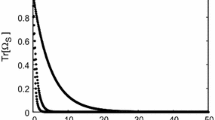Abstract
In the study of open quantum systems modeled by a unitary evolution of a bipartite Hilbert space, we address the question of which parts of the environment can be said to have a “classical action” on the system, in the sense of acting as a classical stochastic process. Our method relies on the definition of the Environment Algebra, a relevant von Neumann algebra of the environment. With this algebra we define the classical parts of the environment and prove a decomposition between a maximal classical part and a quantum part. Then we investigate what other information can be obtained via this algebra, which leads us to define a more pertinent algebra: the Environment Action Algebra. This second algebra is linked to the minimal Stinespring representations induced by the unitary evolution on the system. Finally, in finite dimension we give a characterization of both algebras in terms of the spectrum of a certain completely positive map acting on the states of the environment.
Similar content being viewed by others
References
Aguilar, J.-P., Berglund, N.: The effect of classical noise on a quantum two-level system. Journal of Mathematical Physics 49(10), 102102 (2008)
Attal, S.: Lectures on Quantum Noise Theory. In preparation
Attal, S., Deschamps, J., Pellegrini, C.: Classical Noises Emerging from Quantum Environments
Attal, S., Dhahri, A.: Repeated quantum interactions and unitary random walks. J. Theoret. Probab. 23(2), 345–361 (2010)
Attal, S., Pautrat, Y.: From repeated to continuous quantum interactions. Ann. Henri Poincaré 7(1), 59–104 (2006)
Barchielli, A., Gregoratti, M.: Quantum Trajectories and Measurements in Continuous Time. Volume 782 of Lecture Notes in Physics. Springer, Heidelberg (2009). (The diffusive case)
Barchielli, A., Gregoratti, M.: Quantum continuous measurements: the stochastic Schrödinger equations and the spectrum of the output. Quantum Meas. Quantum Metrol. 1, 34–56 (2013)
Davies, E.: Markovian master equations. Commun. Math. Phys. 39, 91–110 (1974)
Deschamps, J., Nechita, I., Pellegrini, C.: On some classes of bipartite unitary operators. ArXiv e-prints, Sept. (2015)
Fagnola, F.: Quantum Markov semigroups and quantum flows. Proyecciones 18(3), 144 (1999)
Hudson, R.L., Parthasarathy, K.R.: Quantum Ito’s formula and stochastic evolutions. Commun. Math. Phys. 93(3), 301–323 (1984)
Kadison, R.V., Ringrose, J.R.: Fundamentals of the Theory of Operator Algebras: Elementary Theory, vol. 1. American Mathematical Soc., Providence (1997)
Kümmerer, B., Maassen, H.: The essentially commutative dilations of dynamical semigroups on \(M_n\). Commun. Math. Phys. 109(1), 1–22 (1987)
Marshall, A.W., Olkin, I., Arnold, B.C.: Inequalities: Theory of Majorization and its Applications, 2nd edn. Springer Series in Statistics, Springer, New York (2011)
Mendl, C., Wolf, M.: Unital quantum channels—convex structure and revivals of Birkhoff’s theorem. Commun. Math. Phys. 289(3), 1057–1086 (2009)
Meyer, P.-A.: Quantum Probability for Probabilists. Volume1538 of Lecture Notes in Mathematics. Springer, Berlin (1993)
Neumann, J.: Zur Algebra der Funktionaloperationen und Theorie der normalen Operatoren. Mathematische Annalen 102(1), 370–427 (1930)
Pellegrini, C.: Existence, uniqueness and approximation of the jump-type stochastic Schrödinger equation for two-level systems. Stoch. Process. Appl. 120(9), 1722–1747 (2010)
Pellegrini, C.: Markov chains approximation of jump-diffusion stochastic master equations. Ann. Inst. Henri Poincaré Probab. Stat. 46(4), 924–948 (2010)
Rebolledo, R.: Unraveling open quantum systems: classical reductions and classical dilations of quantum Markov semigroups. Conflu. Math. 1(1), 123–167 (2009)
Reed, M., Simon, B.: Methods of Modern Mathematical Physics. I., 2nd edn. Academic Press Inc. [Harcourt Brace Jovanovich Publishers], New York (1980). (Functionalanalysis)
Saira, O.-P., Bergholm, V., Ojanen, T., Möttönen, M.: Equivalent qubit dynamics under classical and quantum noise. Phys. Rev. A 75, 012308 (2007)
Stinespring, W.F.: Positive functions on \(C^*\)-algebras. Proc. Am. Math. Soc. 6, 211–216 (1955)
Takesaki, M.: Theory of Operator Algebras. I. Springer, New York (1979)
Author information
Authors and Affiliations
Corresponding author
Additional information
Communicated by Claude Alain Pillet.
Work supported by ANR-14-CE25-0003 “StoQ”.
Rights and permissions
About this article
Cite this article
Bardet, I. Classical and Quantum Parts of the Quantum Dynamics: The Discrete-Time Case. Ann. Henri Poincaré 18, 955–981 (2017). https://doi.org/10.1007/s00023-016-0517-2
Received:
Accepted:
Published:
Issue Date:
DOI: https://doi.org/10.1007/s00023-016-0517-2




